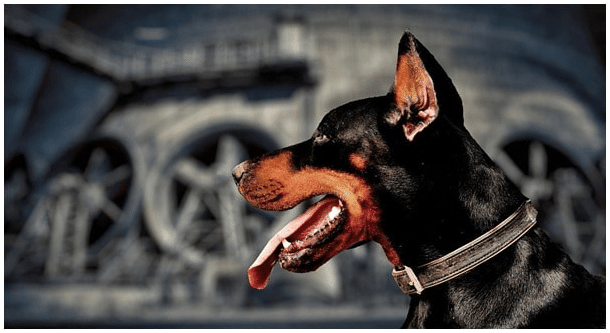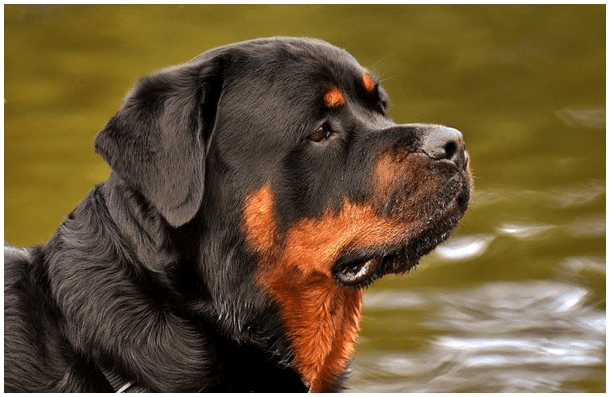As Rottweilers and Dobermans are both strong, protective, and territorial in nature, you may wonder if they would naturally get along.
While they share some obvious personality traits, owners of these breeds should understand some of the key differences that affect their compatibility.
This article looks at the traits and behaviors of both breeds in more detail.
We’ll also establish whether owners of these breeds need to be concerned and what can be done to help a Rottweiler get along with a Doberman.
So, do Rottweilers get along with Dobermans?
In a nutshell, Rottweilers and Dobermans do not get along. This is due to both breeds being highly dominant and fiercely protective. Without proper training and socialization, they are likely to clash and be aggressive toward each other.
Read on further as we share everything you need to know about the relationship between these two breeds, including what you should watch out for.
Rottweilers and Dobermans: Size Difference
To understand if Rottweilers and Dobermans get along, let’s first look at their size differences.
Rottweilers are a large, muscular, imposing breed that typically grows to around 30 inches tall, and weighs between 90 and 130 pounds.
At the extreme end, some Rotties have been known to exceed 150 pounds.
They are known to have a wide variety of colors, including rust red, black or dark brown with tan markings; solid black; or deep mahogany red without any other markings.
In rare cases, other colors have been seen such as pure white without any other markings (known as “white Rotties”); and various shades of gray which may include blue undertones (“blue Rotties”).
Originally bred in Germany, Rotties were used to herd cattle, pull carts, and protect their master’s property.
A by-product of the Rotties’ breeding history is that they are extremely protective of their owners and may be territorial at times.
On the other hand, the Doberman is a medium-to-large-sized breed also originating from Germany.
Created by Friedrich Louis Dobermann, this breed had the dangerous job of guarding and protecting its creator due to his job as a tax collector.
Dobies are very lean and athletic looking and can grow up to 28 inches tall and typically weigh between 60-100 pounds.
They are a lively breed and come in three different colors: tan/fawn, black, or blue, though they can also be found with white markings on their chest, feet, snout, or tail tip.
You may also like – Beauceron vs Doberman: What are 17 Key Differences?
Temperament Compared
Dobermans are a very protective, loyal breed that doesn’t like to share their people with other animals.
They will not hesitate to defend their territory from intruders, largely due to their fiercely protective instincts.
“This level of protectiveness makes them an excellent watchdog for your property if you live in a neighborhood where crime rates are high.“
While they can be suspicious and aggressive towards unfamiliar people or animals outside of the home, they are very gentle and affectionate to their family members.
Choosing a reputable breeder is therefore important and can impact the type of temperament your Dobie has.

Even if you find a reputable breeder, they are not recommended for first-time dog owners due to their training and attention needs.
Rottweilers, on the other hand, may seem intimidating to many; however, they are quite friendly in general.
They love being around children and their loved ones but are known to be extremely loyal and protective of their families.
This is especially the case if they feel they are being threatened or mistreated.
Depending on their upbringing, these instincts can sometimes be hard to handle and result in aggression.
Rotties tend to be one-person dogs who love their owners, but they may not get along with everyone else in the home.
They can also be challenging to train since this breed is stubborn and strong-willed.
They are also known for testing you for dominance, as they figure out your place in the pack.
Because of these traits, it is best to make sure that you begin early training with your dog using positive reinforcement techniques.
“This will establish you as your pet’s role model, pack leader, and master from an early age.”
As the Doberman and Rottweiler are both extremely protective of their loved ones, this can lead to aggression in certain circumstances.
The two breeds may clash in the pursuit of being the pack leader. Owners should ensure both breeds are socialized and introduced carefully to avoid any unfortunate accidents.
Guarding Instincts
Rottweilers are well known for their loyalty and guarding instincts. This, of course, is no surprise when you consider their breeding history!
If an owner wants them to guard, they will be very protective of their property and family. However, if owners are just looking for a companion, they will need to accept that Rotties will put their guarding duties first!
This can be a problem at times, especially when introducing another dog under the same roof as the Rottie.
They will automatically feel the need to protect you and their home from this new addition.
The same applies when taking your Rottie for a walk. While you may see this as a simple exercise session, they see it differently.
In their eyes, they are going for a walk but they are also guarding you in the process.
“Unless they have been socialized enough prior, they are likely to become over-protective if they see another dog or a strange person nearby.”
Dobermans are also highly protective of their territory and family and make great guard dogs.
Similar to Rotties, they were bred to guard and protect their loved ones and are very effective at it too!
While they are physically imposing and have a loud resonating bark, they are much more than just a watchdog.
They will not hesitate to attack if the situation requires it and will scare away almost any intruder.

While both breeds are natural guard dogs, they often struggle to understand their place when placed together.
This is because they may feel the need to compete for the lead position, which could result in conflict.
Are They Territorial?
Along with a Rotties protective instincts, they also have a high prey drive. This refers to their love for the hunt and the chase.
When combining these traits, a common by-product is that they become territorial.
This means they will show dominance towards other dogs and protect ‘their space’ at all costs. Unfortunately, this behavior can quickly escalate to aggression if not managed.
“On the other hand, Dobermans are also considered highly territorial – especially with other dogs – and have a high prey drive.”
Therefore, when it comes to introductions between these two breeds, caution is definitely recommended.
Without proper training and socialization, both breeds can become very competitive for dominance as they age.
Dominance
Both Rotties and Dobermans are confident, self-assured breeds that have strong dominant traits.
Both breeds need to be trained early on in life to ensure their dominance doesn’t become a problem when they get older.
This means that owners need to take the lead and teach them boundaries and rules, otherwise they will make their own!

Along with providing structure, owners also need to establish themselves as pack leader at all times.
If either breed feels like he is the head of the house, he will likely display bad behavior and become dominant and show aggression. This can be towards other pets in your home and even family members!
First-time dog owners may struggle with this, however, the sooner this is embraced and understood the better.
“It’s best not to take any chances when introducing these two breeds. As both have strong protective instincts and are quite territorial, caution must be exercised.“
For this reason, strict obedience training and socialization are necessary for the Rottie and Doberman, and it needs to start at a young age.
Energy Levels Compared
Another way to check if Rottweilers and Dobermans get along is to check their differences in energy levels.
Rotties are known as having medium to high energy levels and are typically very playful.
They love nothing more than a brisk walk or run in the park. They also enjoy playing fetch and any type of fun activity.
Along with physical exercise, Rotties also need mental stimulation. This could include puzzles, games, or anything that makes them work on their problem-solving skills.
Without the right amount of physical and mental exercise, they are likely to cause problems for their owners.
This could include restless behavior, digging, chewing, or even aggression at times.
Dobermans, on the other hand, are even higher in energy than Rotties.

They need plenty of exercise and mental stimulation to keep happy and healthy.
As they have higher energy levels, this could cause them to annoy the Rottie. This is especially the case if the Dobie can’t tell when its’ Rottie friend is tired and wants to rest.
On the other hand, both breeds can be a good match when they are both in the mood to play.
When this happens, they can keep each other entertained without you needing to be involved.
Rottweilers and Dobermans: Training Needs
Rotties are typically fairly easy to train as long as their training starts early.
As they are quite intelligent, they respond well to obedience training and socialization, especially when positive reinforcement is used.
I’ve found that simple commands used consistently, along with lots of verbal praise and treats, work really well.
On the other hand, Rotties don’t respond too well to any type of negative reinforcement. This could include yelling, or any type of physical discipline.
Whilst this may correct their behavior in the short term, it only confuses them and causes anxiety.
“As they are quick learners and have no problems associating a treat with good behavior, I’ve used this countless times for some great results.”
On the other hand, Dobermans are also very intelligent and are not difficult to train. Like the Rottie, they need their training from an early age to ensure the right behaviors are established early.
Dobies love pleasing their owners, so training can be very effective if lots of verbal praise is used.
So, how does the level of training provide impact the two breeds getting along?
This is a huge factor in the Rottie and Dobie getting along.
Early training and socialization will help them both understand boundaries, including what is acceptable around others.
They will learn to obey commands when given. So, if their behavior becomes a bit unruly, they will stop when instructed to do so.
They will be less likely to show dominance towards the other, as they have been socialized when they were younger. So, rather than focusing on being the leader, they are more interested in having lots of fun.
While this is quite achievable between the breeds, it will only happen if they are properly trained as puppies and socialized with other dogs from a young age.
Are Rottweilers and Dobermans Compatible?
So, do Rottweilers and Dobermans get along? Unfortunately, for the reasons mentioned in today’s article, these two dogs are not made to live together.
While they can get along if they have been suitably trained and socialized early, there is a high risk for conflict when it comes to dominance and guarding instincts.
All in all, these two breeds are not a good match and should only be brought together if they are closely supervised.


